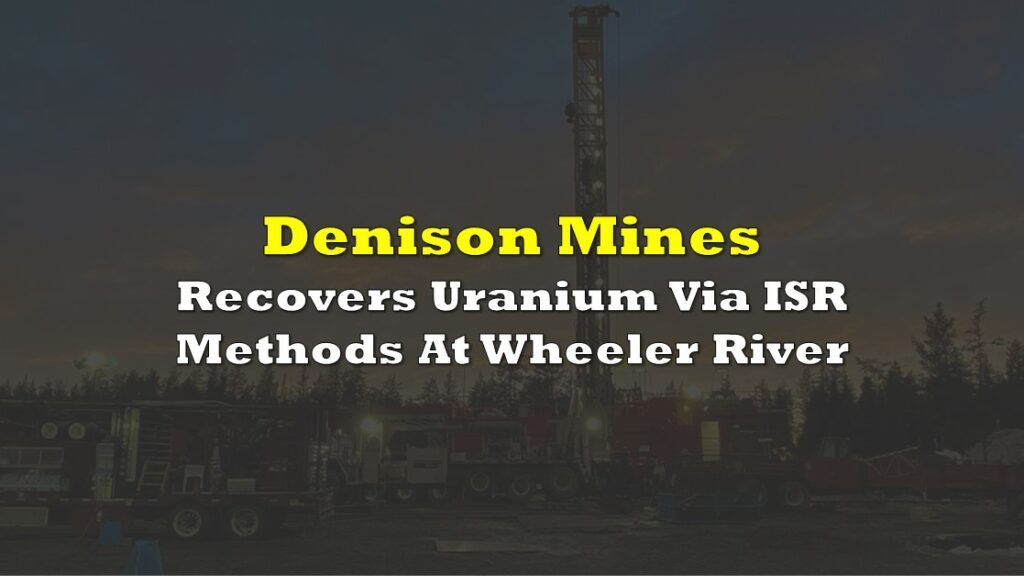The Canadian Nuclear Safety Commission, or CNSC, announced on November 20, 2024, the completion of its technical review of Denison Mines Corp.’s (TSX: DML) responses to outstanding information requests for the proposed Wheeler River Uranium Project in northern Saskatchewan. The CNSC confirmed that all information requests are now deemed accepted, marking a significant milestone in the regulatory approval process for the controversial uranium extraction initiative.
Shortly after, the company announced the submission of its final environmental impact statement (EIS) to the CNSC, signaling the completion of a rigorous technical review phase under the federal environmental assessment (EA) process.
The company is proposing to establish an in situ recovery uranium mine and processing facility at the Wheeler River site, located approximately 600 kilometers north of Saskatoon in the resource-rich Athabasca Basin. If approved, the project would produce up to 5,400 tonnes of uranium oxide (U₃O₈) annually over a 20-year operational period.
Denison Mines CEO, David Cates, described the milestone as a significant step toward regulatory approval, emphasizing the project’s environmental sustainability and economic potential. “The EIS evidences that the Project can be constructed, operated, and decommissioned while achieving a superior standard of environmental sustainability when compared to conventional uranium mining operations,” Cates said.
The proposed project, situated near Cameco Corporation’s (NYSE: CCJ) Key Lake Mill and McArthur River Mine, represents a strategic effort to strengthen Canada’s uranium supply chain in a global energy market increasingly focused on low-carbon nuclear power.
Under the Nuclear Safety and Control Act, the project requires approval from the CNSC, alongside an environmental assessment under the Canadian Environmental Assessment Act, 2012. The EA must confirm that the proposed operations would not cause significant adverse environmental effects, a critical step before the CNSC can grant a license.
The Wheeler River Project is the largest undeveloped uranium resource in the area. It is centered on two high-grade uranium deposits—Phoenix and Gryphon—discovered by Denison in 2008 and 2014. The project is a joint venture between Denison Mines (90% ownership and operator) and JCU Exploration Company Limited (10%).
Regulatory Milestone
On November 20, CNSC staff concluded their review of Denison’s responses to information requests, including supplemental submissions addressing environmental and Indigenous concerns. According to CNSC documents, “the information fully addresses the regulatory requirements for the environmental assessment. All responses to information requests are now deemed as accepted.”
The review process has been extensive, involving contributions from the Federal-Indigenous Review Team, Indigenous communities, environmental experts, and public stakeholders. Notable documents released include:
- Annex 1: Results of the Federal Indigenous Technical Review of the Wheeler River Project.
- Supplementary Submissions: Updated environmental studies, including bat population surveys and water quality impact analyses.
Over 500 public comments were submitted during the draft EIS review process, which ran from November 2022 to March 2023.
Jessica Way, an Environmental Review Specialist at CNSC, emphasized the importance of ensuring all responses are consistent with regulatory standards. “Should CNSC staff deem Denison’s Final EIS submission as acceptable, the EA Report summarizing the results of the technical review and staff recommendations will be drafted for the Commission,” Way noted in an official letter.
A cornerstone of the review process has been the engagement of Indigenous communities and the incorporation of traditional knowledge. Letters of consent and support for the project have been secured from several key stakeholders, including English River First Nation, Kineepik Métis Local #9, and municipalities including Pinehouse Lake, Beauval, Île-à-la-Crosse, Jans Bay, and Cole Bay.
Denison has submitted detailed Indigenous Engagement Reports and a revised Commitments Register, outlining measures to address concerns about the project’s potential impacts on traditional lands, local ecosystems, and cultural heritage.
Denison has also addressed concerns raised during public consultations, particularly regarding potential groundwater contamination and the long-term stability of the in-situ recovery method. The company’s October 30 submission included updated ecological surveys and strategies to mitigate risks to wildlife, including bat populations, which have been a focal point for environmental groups.
What’s Next?
The CNSC’s acceptance of Denison’s technical responses clears the way for the submission of the Final EIS package, which is expected to address all remaining public and Indigenous feedback. The Final EIS is slated to undergo a 30-day CNSC review period to confirm compliance with regulatory requirements.
A crucial step in the regulatory process involves Denison ensuring that all documents reflect changes requested by stakeholders. Following this, CNSC staff will prepare the EA report summarizing the technical review and their recommendations to the Commission. If the Final EIS is accepted, public hearings will be scheduled, providing an opportunity for further input before a licensing decision is made.
In parallel, Denison has advanced its application for a CNSC license to prepare and construct a uranium mine and mill. Notably, this licensing decision will be made concurrently with the EA process, streamlining regulatory approvals.
On the provincial level, Denison filed its Final EIS with the Saskatchewan Ministry of Environment in October 2024. The provincial EA process is expected to conclude in December 2024 following a public review period. By synchronizing federal and provincial processes, Denison aims to minimize delays and expedite final approvals.
Although the CNSC has not provided a definitive timeline, Denison remains optimistic about advancing the project.
The Wheeler River Project is seen as a bellwether for the future of uranium mining in Canada, particularly as global demand for nuclear energy rises amidst efforts to combat climate change. If approved, the project could bolster Canada’s position as a leading supplier of uranium, while setting a precedent for environmental and Indigenous consultations in resource development projects.
Denison Mines last traded at $3.32 on the TSX.
Information for this briefing was found via the sources mentioned. The author has no securities or affiliations related to this organization. Not a recommendation to buy or sell. Always do additional research and consult a professional before purchasing a security. The author holds no licenses.









